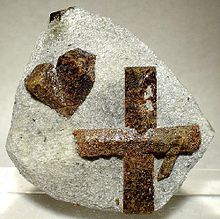| Staurolite | |
|---|---|
 Staurolite from Pestsovye Keivy, Keivy Mountains, Kola Peninsula, Murmanskaja Oblast', Northern Region, Russia, 2.5 × 2.2 × 1 cm | |
| General | |
| Category | Nesosilicate |
| Formula (repeating unit) | Fe2+2Al9O6(SiO4)4(O,OH)2[1] |
| IMA symbol | St[2] |
| Strunz classification | 9.AF.30 |
| Crystal system | Monoclinic |
| Crystal class | Prismatic (2/m) (same H-M symbol) |
| Space group | C2/m |
| Unit cell | a = 7.86 Å, b = 16.6 Å c = 5.65 Å; β = 90.45°; Z = 2 |
| Identification | |
| Color | Dark reddish brown to blackish brown, yellowish brown, rarely blue; pale golden yellow in thin section |
| Crystal habit | Commonly in prismatic crystals |
| Twinning | Commonly as 60° twins, less common as 90° cruciform twins |
| Cleavage | Distinct on {010} |
| Fracture | Subconchoidal |
| Tenacity | Brittle |
| Mohs scale hardness | 7 – 7.5 |
| Luster | Subvitreous to resinous |
| Streak | White to grayish |
| Diaphaneity | Transparent to opaque |
| Specific gravity | 3.74 – 3.83 meas. 3.686 calc. |
| Optical properties | Biaxial (+) |
| Refractive index | nα = 1.736 – 1.747 nβ = 1.740 – 1.754 nγ = 1.745 – 1.762 |
| Birefringence | δ = 0.009 – 0.015 |
| Pleochroism | X = colorless; Y = pale yellow; Z = golden yellow |
| 2V angle | Measured: 88°, Calculated: 84° to 88° |
| Dispersion | r > v; weak |
| References | [3][4][5] |
Staurolite is a reddish brown to black, mostly opaque, nesosilicate mineral with a white streak. It crystallizes in the monoclinic crystal system, has a Mohs hardness of 7 to 7.5 and the chemical formula: Fe2+2Al9O6(SiO4)4(O,OH)2. Magnesium, zinc and manganese substitute in the iron site and trivalent iron can substitute for aluminium.[1]
- ^ a b Klein, Cornelis and Cornelius S. Hurlbut, Jr., Manual of Mineralogy, Wiley. 20th ed., 1985, p. 382 – 3 ISBN 0-471-80580-7
- ^ Warr, L.N. (2021). "IMA–CNMNC approved mineral symbols". Mineralogical Magazine. 85 (3): 291–320. Bibcode:2021MinM...85..291W. doi:10.1180/mgm.2021.43. S2CID 235729616.
- ^ http://rruff.geo.arizona.edu/doclib/hom/staurolite.pdf Handbook of Mineralogy
- ^ http://www.mindat.org/show.php?id=3753&ld=1&pho= Mindat.org
- ^ http://webmineral.com/data/Staurolite.shtml Webmineral data